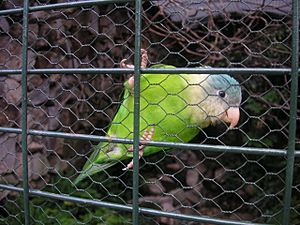Grey-cheeked parakeet facts for kids
Quick facts for kids Grey-cheeked parakeet |
|
|---|---|
 |
|
| Conservation status | |
| Scientific classification | |
| Genus: |
Brotogeris
|
| Species: |
pyrrhoptera
|
 |
|
The grey-cheeked parakeet (Brotogeris pyrrhoptera) is a small, colorful bird. It's also sometimes called the fire-winged parakeet. This bird is a type of parrot found only in Ecuador and Peru. Sadly, it is considered a Vulnerable species, meaning its population is decreasing.
Contents
About the Grey-cheeked Parakeet's Family
Scientists like to group living things to understand them better. This is called taxonomy. The grey-cheeked parakeet was first described by a scientist named John Latham in 1801. It is the only type of its kind, meaning it has no subspecies. It is closely related to the orange-chinned parakeet.
What Does the Grey-cheeked Parakeet Look Like?
This parakeet is about 19 to 20.5 cm (7.5 to 8.1 in) long. It weighs between 60 and 68 g (2.1 and 2.4 oz), which is about as much as a small apple. Most of its body is green. Its belly is a lighter, more yellowish green.
It has a light blue top of its head. Its cheeks and the sides of its neck are a pale gray color. Around its eyes, there's a whitish ring, and its beak is also whitish. The feathers under its wings are a bright orange or orange-red. Young parakeets have green crowns instead of blue ones.
Where Do Grey-cheeked Parakeets Live?
The grey-cheeked parakeet lives in western Ecuador. Its home stretches south into the very northwest part of Peru. You can find it in many different places. These include forests where trees lose their leaves and forests where trees stay green. They also live in more open woodlands, scrublands, and even farm areas.
In the northern parts of its range, it lives in lower areas, up to 300 m (1,000 ft) high. But in the south, it can be found higher up, reaching 1,550 m (5,100 ft) in elevation.
How Do Grey-cheeked Parakeets Behave?
Seasonal Movements
Scientists believe that grey-cheeked parakeets might move from one area to another depending on the season. These movements help them find food or better places to live.
What Do They Eat?
The grey-cheeked parakeet enjoys a varied diet. They eat flowers, seeds, and fruits from many different plants. It's also thought that they might eat cultivated bananas.
Life Cycle and Reproduction
The main time for grey-cheeked parakeets to have babies is from January to March. They often build their nests inside natural holes in large, hollow tree branches. Sometimes, they even dig out nests inside termite nests that are built in trees.
When kept in captivity, a female parakeet usually lays four to seven eggs. The young birds are ready to fly about six weeks after they hatch.
How Do They Communicate?
Grey-cheeked parakeets are known to be quite noisy birds. They make many different kinds of calls. Some of their calls are described as "chree," "chree-chree," and "cra-cra-cra-cra-cra." When these birds are in a flock, they often call out all at the same time.
Grey-cheeked Parakeets as Pets
Even in the places where they live naturally, grey-cheeked parakeets are often kept as pets. With enough patience and training, these birds can learn to copy human sounds. However, their voices might not be as clear as those of larger parrots.
Why Is This Parakeet Vulnerable?
The IUCN (International Union for Conservation of Nature) keeps track of how many animals are left in the wild. They first listed the grey-cheeked parakeet as "Threatened." Then, in 2000, it was changed to "Endangered," which is a more serious warning. But since 2021, it has been moved to "Vulnerable." This means it's still at risk, but not as critically as before.
There are about 10,000 adult grey-cheeked parakeets left. This number is believed to be getting smaller. The biggest dangers to these birds are two things:
- Illegal pet trade: People illegally catch these birds to sell them as pets.
- Habitat loss: Their natural homes are being destroyed.
Forests are being cleared for farms, logging, and animals like goats and cattle grazing. This stops new trees from growing, which is very bad for the forests they live in. It also means fewer places for them to build their nests. Both Ecuador and Peru have banned the export of these parakeets to protect them. The species also lives in at least four protected areas.
See also
 In Spanish: Periquito cachetigrís para niños
In Spanish: Periquito cachetigrís para niños



